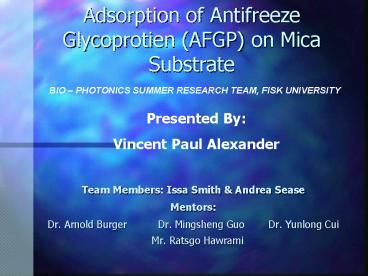Adsorption of Antifreeze Glycoprotien AFGP on Mica Substrate - PowerPoint PPT Presentation
1 / 14
Title:
Adsorption of Antifreeze Glycoprotien AFGP on Mica Substrate
Description:
Team Members: Issa Smith & Andrea Sease. Mentors: ... Protein solutions using distilled and deionized water will be prepared from the ... – PowerPoint PPT presentation
Number of Views:167
Avg rating:3.0/5.0
Title: Adsorption of Antifreeze Glycoprotien AFGP on Mica Substrate
1
Adsorption of Antifreeze Glycoprotien (AFGP) on
Mica Substrate
BIO PHOTONICS SUMMER RESEARCH TEAM, FISK
UNIVERSITY
Presented By Vincent Paul Alexander
- Team Members Issa Smith Andrea Sease
- Mentors
- Dr. Arnold Burger Dr. Mingsheng Guo Dr. Yunlong
Cui - Mr. Ratsgo Hawrami
2
ANTIFREEZE GLYCOPROTEINIts Chemical Make - Up
CH3
- hydrophobic amino acids alanine (2)
- and threonine (1)
- hydrophilic
- disaccharides
- galactosyl and
- galactosine
GLYCO
3
ANTIFREEZE GLYCOPROTEINAnd its conjunction with
Mica
- If you noticed, when the glycoprotein
is in contact with the Mica, it spreads over a
wider area on the sample due to Micas love for
water.
AFGP
- Mica is a mineral crystal and adheres very
well to water with OH through hydrogen bonding.
Mica is widely used in this research because of
the hydrophilic and hydrophobic properties that
AFGP possesses.
Mica Sample
- Unlike the HOPG sample, the AFGP doesnt bead
on the Mica surface.
Actual microscopic picture of AFGP on Mica (x 100)
4
TAKING CARE OF BUSINESS Sample Preparation
- Protein solutions using distilled and deionized
water will be prepared from the
following solutions. 0.2, 0.5 mg/mL - One drop of solution was deposited onto a mica
substrate. The sample was then be dried under N2
over night.
Dried AFGP / Mica sample.
Mica sample being placed in the gas chamber.
N2 gas drying chamber
5
TAKING CARE OF BUSINESS Sample Preparation
Continued
Throughout the research deposit of dust
accumulated on the mica sample. Here are the
steps I took to fix the problem.
The actual Mica material is made up in layers. I
took the sample and tried to wipe off the surface.
When that didnt work I took a piece of box tape
and applied it to the entire Mica surface.
When I took the adhesive tape off, the layer with
the old AFGP came off as well.
6
THE RAMAN SPECTROMETER
- Raman spectrometer
- Raman spectroscopy is the measurement of the
wavelength and intensity of scattered light from
molecules generated by a helium neon laser
source. The Raman scattered light occurs at
wavelengths that are shifted from the incident
light by the energies of molecular vibrations.
7
RAMAN SPECTROMETER
- Measures molecule vibrations and rotation of any
sample. - Filter Sizes
- - _ _ _ 11mw- D0.3 11nw / 2-
D0.6 11mw / 4- D1 11mw /
10- D2 11mw / 100- D3
11mw / 1000- _ _ _ _ no filter
OFTEN USED
Scheme function of the Raman software.
Uses HeNeon Laser Wavelength 632.8 nm
8
MICAS TRUE SELFView through the Raman
Spectroscope
Here is the vibration and rotation of molecules
that Mica produces depicted by Raman.
9
AFGP THROUGH THE EYES OF RAMAN
Here is the Raman for the AFGP ONLY! The circled
region signifies the bond of the AFGP chemical
structure vibrating.
10
AFGP FOUND on MICA THROUGH RAMAN
AFGP found in Mica.
Areas of Spectra
Due to the vibration found through the AFGP
spectra, this spectra of Mica shows the same peak
as the previous one signifying that AFGP is
present on its surface.
11
NEW PEAKS FOUND
C
A
B
AFGP ON MICA (X 100)
AFGP ON MICA AT EDGE (X 10)
AFGP ON MICA (X 100)
Figures A, B, and C showed to have the 0.5 mg/mL
concentration of AFGP deposition on that
particular mica sample. There new peaks were
found in A and C view on the residual spot. There
is no new peaks on the edge in B view.
12
NEW PEAKS FOUND continued..
No new peak on edge
Figure Above New Peaks of Antifreeze
Glycoprotein on Mica substrate The red lines
indicate the position of the possible new peaks
at 1354cm-1 and 1507cm-1.
13
NEW PEAKS FOUND continued
Figure Above New Peaks of AFGP on Mica
substrate This is a spectrum of the evident new
peaks that were discovered. These new peaks are
at 1354 cm-1 .
14
REASONS FOR NEW PEAK DISCOVERY
- One possible reason for a new peak being valid is
because of the generation of a V(CC)ring
structure, which has very close Raman spectra
feature on 1354 cm-1 and 1507 cm-1. If this were
to be true, that would mean that there is a
possible formation of carbon rings fusing to a
net structure of either nitrogen or oxygen from
the AFGP. - Another idea is that the new peak near the 1354
cm-1 range is evident because of micas molecules
possess hydroxyl function groups (-OH). So this
might be made possible due to hydrogen bonding
taking place because pf micas hydrophilic
nature. Otherwise, AFGP also can form N-O with
Mica.































